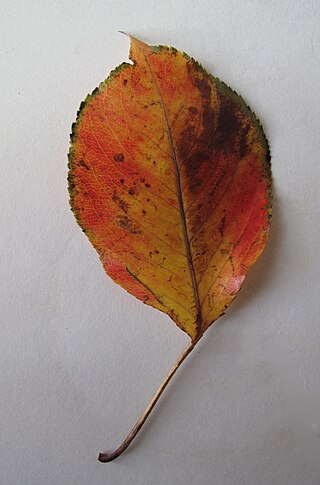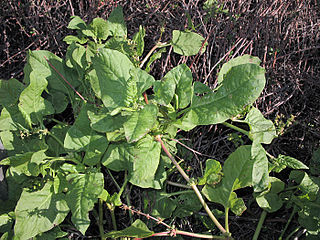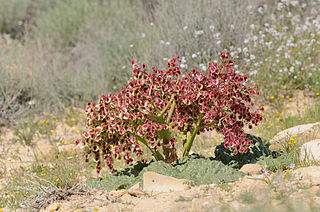
The Polygonaceae are a family of flowering plants known informally as the knotweed family or smartweed—buckwheat family in the United States. The name is based on the genus Polygonum, and was first used by Antoine Laurent de Jussieu in 1789 in his book, Genera Plantarum. The name may refer to the many swollen nodes the stems of some species have, being derived from Greek [poly meaning 'many' and gony meaning 'knee' or 'joint']. Alternatively, it may have a different origin, meaning 'many seeds'.

Spearmint, also known as garden mint, common mint, lamb mint and mackerel mint, is a species of mint, Mentha spicata (, native to Europe and southern temperate Asia, extending from Ireland in the west to southern China in the east. It is naturalized in many other temperate parts of the world, including northern and southern Africa, North America, and South America. It is used as a flavouring in food and herbal teas. The aromatic oil, called oil of spearmint, is also used as a flavoring and sometimes as a scent.

Rhubarb is the fleshy, edible stalks (petioles) of species and hybrids of Rheum in the family Polygonaceae, which are cooked and used for food. The plant is a herbaceous perennial that grows from short, thick rhizomes. Historically, different plants have been called "rhubarb" in English. The large, triangular leaves contain high levels of oxalic acid and anthrone glycosides, making them inedible. The small flowers are grouped in large compound leafy greenish-white to rose-red inflorescences.

Bistorta officinalis, known as bistort, common bistort, European bistort or meadow bistort, is a species of flowering plant in the dock family Polygonaceae native to Europe and northern and western Asia. Other common names include snakeroot, snake-root, snakeweed and Easter-ledges.

Smyrnium olusatrum, common name alexanders is an edible flowering plant of the family Apiaceae (Umbelliferae), which grows on waste ground and in hedges around the Mediterranean and Atlantic coastal regions of Europe. It was formerly widely grown as a pot herb, but is now appreciated mostly by foragers.

Rheum palmatum is a species of flowering plant in the knotweed family Polygonaceae. It is commonly called Chinese rhubarb, ornamental rhubarb, Turkey rhubarb or East Indian rhubarb.

Rheum nobile, the Sikkim rhubarb or noble rhubarb or पदमचाल, is a giant herbaceous plant native to the Himalaya, from northeastern Afghanistan, east through northern Pakistan and India, Nepal, Sikkim, Bhutan, and Tibet to Myanmar, occurring in the alpine zone at 4000–4800 m altitude.

Rheum is a genus of about 60 herbaceous perennial plants in the family Polygonaceae. Species are native to eastern Europe, southern and eastern temperate Asia, with a few reaching into northern tropical Asia. Rheum is cultivated in Europe and North America. The genus includes the vegetable rhubarb. The species have large somewhat triangular shaped leaves with long, fleshy petioles. The flowers are small, greenish-white to rose-red, and grouped in large compound leafy inflorescences. A number of cultivars of rhubarb have been domesticated both as medicinal plants and for human consumption. While the leaves are slightly toxic, the stalks are used in pies and other foods for their tart flavor.

Rheum officinale, the Chinese rhubarb, or Indian rhubarb is a rhubarb from the family Polygonaceae native to China. In Chinese it is called yào yòng dà huáng, literally meaning medicinal rhubarb.

In botany, the petiole is the stalk that attaches the leaf blade to the stem. It is able to twist the leaf to face the sun, producing a characteristic foliage arrangement, and also optimizing its exposure to sunlight. Outgrowths appearing on each side of the petiole in some species are called stipules. The terms petiolate and apetiolate are applied respectively to leaves with and without petioles.

Rumex spinosus, commonly known as devil's thorn, spiny dock, or lesser jack, is an annual herbaceous plant of the Polygonaceae. It originates in the warmer parts of the old world, but now has spread with humans to other places. It is common in disturbed areas, especially in sandy soils. It has shown some weedy behaviour in restricted areas within southern Australia.

Oxyria is a genus of plants in the family Polygonaceae with three accepted species as of March 2019. It has a circumboreal distribution.

Rheum palaestinum, the desert rhubarb, is a plant indigenous to Israel and Jordan with a highly developed system for gathering rainwater.

Rheum rhabarbarum is a species of flowering plant in the family Polygonaceae, native to a region stretching from southern Siberia to north and central China. It has been harvested from the wild for centuries for its root, which was harvested for use as a popular medicine in Europe and Asia. It was later cultivated for its root in England and Russia. It is considered to be one of the species involved in the development of culinary rhubarb, for which the scientific name R. rhabarbarum is sometimes (erroneously) used.

Rheum australe, synonym Rheum emodi, is a flowering plant in the family Polygonaceae. It is commonly known as Himalayan rhubarb, Indian rhubarb and Red-veined pie plant. It is a medicinal herb used in the Indian Unani system of medicine, and formerly in the European system of medicine where it was traded as Indian rhubarb. The plant is found in the sub-alpine and alpine Himalayas at an altitude of 4000 m.

Rheum maximowiczii is a large herbaceous perennial plant species in the genus Rheum (rhubarbs) from the mountains of Central Asia where it grows in Kazakhstan, eastern Uzbekistan, Tajikistan, Kyrgyzstan and northeastern Afghanistan.

Rheum ribes, the Syrian rhubarb or currant-fruited rhubarb, or warty-leaved rhubarb, is an edible wild rhubarb species in the genus Rheum. It grows between 1000 and 4000 m on dunite rocks, among stones and slopes, and is now distributed in the temperate and subtropical regions of the world, chiefly in Western Asia to Afghanistan and Pakistan and also in ladakh(Kargil) region of India. The Syrian rhubarb is a partially commercial vegetable collected from wild patches in Eastern and Southern Anatolia, Northern Iraq and partly Northwestern Iran in early spring. Rheum ribes is considered as a valuable medicinal species in herbal medicine.
Iris ludwigii, with the common name Ludwig iris, is a species in the genus Iris. It is also in the subgenus Iris subg. Limniris and in the series Spuriae. It is a rhizomatous perennial plant with violet-blue flowers. It is native to the Altai Mountains in Central Asia, where Russia, China, Mongolia, and Kazakhstan meet. It is cultivated as an ornamental plant in temperate regions.
Rheum lhasaense is a plant from eastern Tibet belonging to the genus Rheum in family Polygonaceae. It is a mid-sized rhubarb species with triangular leaves and spherical fruit.

Rheum webbianum is a species of herbaceous perennial rhubarb-relative in the family Polygonaceae from the southwestern Himalayan region, known in (Indian) English as Indian rhubarb, Gilgiti rhubarb or small Himalayan rhubarb.

















